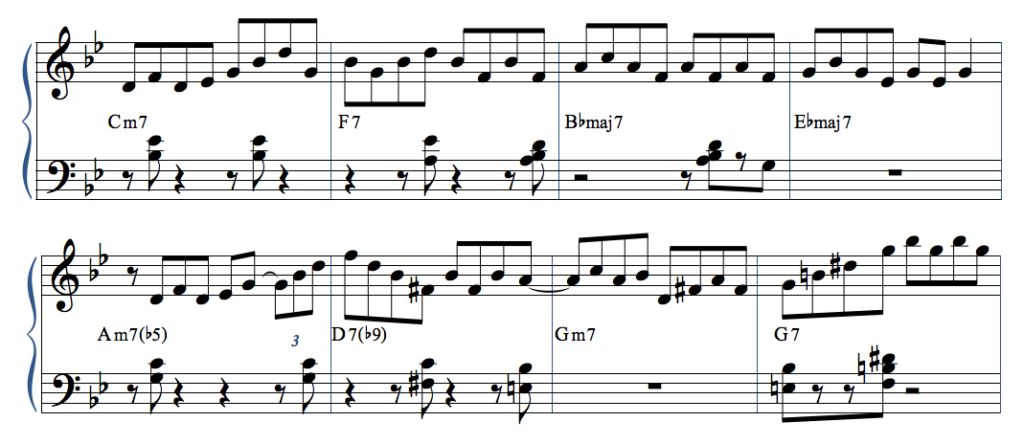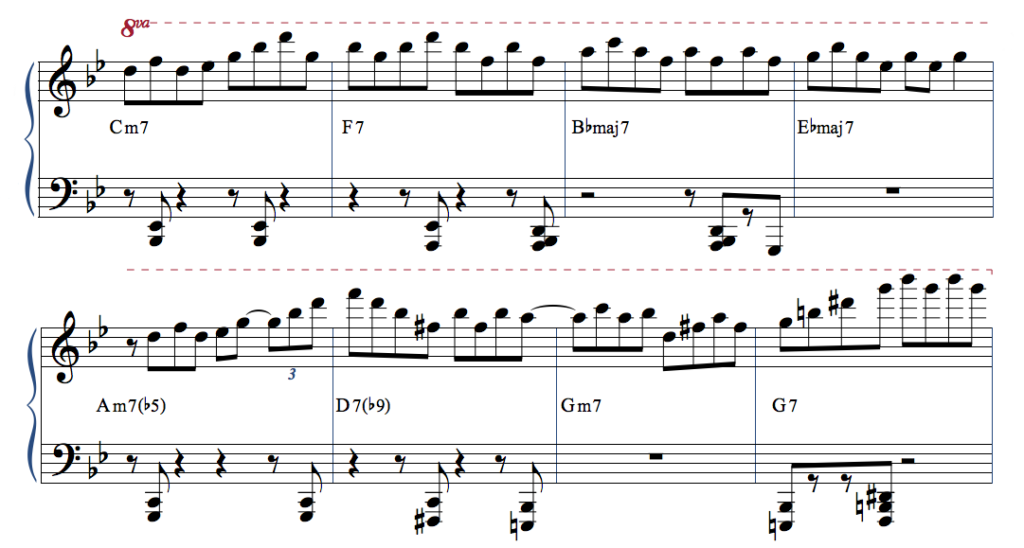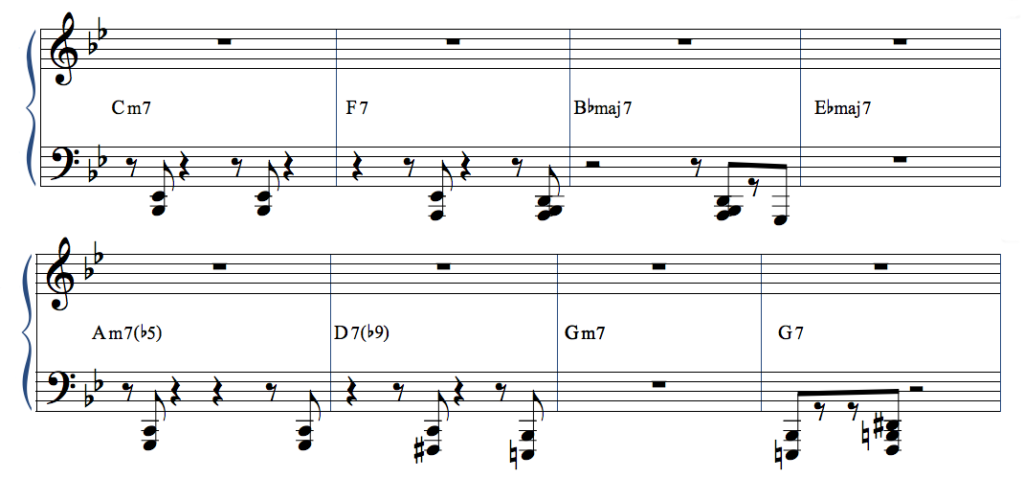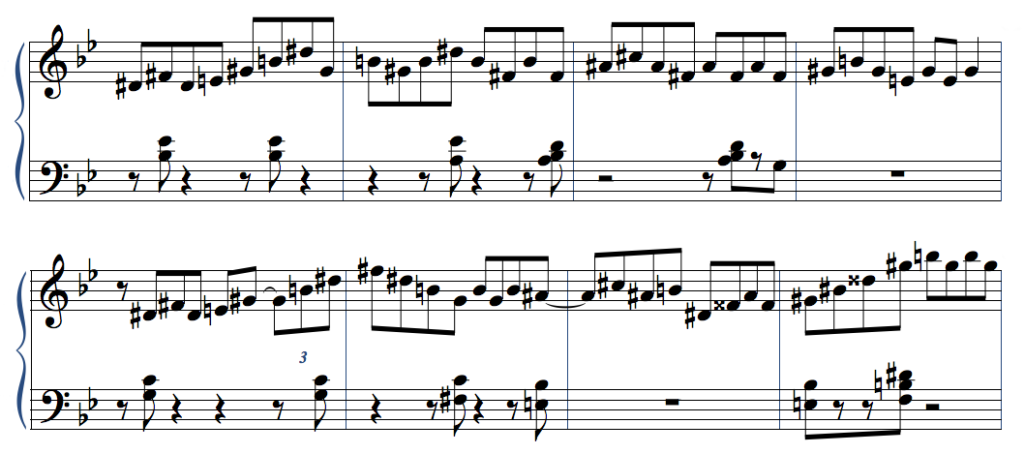Spatial Relationships at the Piano
Full 2600-word article available on (Patreon)
—
In the previous article, I explored active and passive relationships as a starting point for understanding how improvising pianists split attention between their hands. Pianists can use larger clusters of notes in BOTH hands to create the illusion of two separate and active voices. With both hands using higher levels of abstraction, a more holistic relationship emerges that includes the right hand, the left hand, and both hands together.
Discussing this holistic relationship in these terms may seem unfamiliar, but in practice, even amateur jazz pianists will have experience with this. This is demonstrated easily with two-handed voicings:
These voicings, made famous from Miles Davis’s So What, are stock vocabulary for jazz pianists. The arrangement between the hands is so ingrained that their structure could be used as abstracts, and extrapolated like this:
A pianist’s method of extrapolation is largely influenced by a holistic relationship between the hands. In this case, the two notes in the left hand and three notes in the right hand (2-3) form one unit that’s characterized by the distribution of notes between the hands, the fingers used to play them, the spatial distance between the hands, and the spatial distance from the body. To demonstrate further, if we change the spatial arrangement in the voicings from 2-3 to 3-2, we would get this:
This sounds identical, but creates a vastly different physical relationship between the hands. Depending on the skill of the pianist, this new physical arrangement would result in a different method of extrapolation and different improvisatory decisions. If we keep the same musical arrangement as above, you can clearly see (and feel) the different rhythmic interplay between the hands:
It might not sound like they’re codependent, but the hands are physically working together spatially, rhythmically, directionally and functionally while improvising. These relationships are at the heart of a pianist’s improvisatory choices and influence how they extrapolate from larger clusters of notes and higher levels of abstraction. Improving hand independence and counterpoint is a matter of practicing exercises that target these relationships. They all overlap in practice to some degree, but I think it’s important to try and isolate them, and discuss them in detail.
—
Spatial Relationships
—
“Music is the space between the notes.”
-Claude Debussy
Debussy’s quote contemplates the relationship between sound and silence. In keeping with the theme of these articles though, for musicians and improvisors, there is no such thing as a “note” unless paired with some physical gesture. The “space between notes” then, literally means the space and relationship between instrument and body.
For pianists, I use “spatial relationships” to characterize the spatial distance of the hands from the body, the spatial distance between the hands, the distribution of notes between the hands, and the fingers used to play them. An even moreholistic characterization would include the positioning of the body in relation to the piano, posture, wrist/finger technique, and the breath. However, these are probably best left to a specialist in a subject like Alexander Technique, so I’ll leave that for future exploration.
Practicing for improvisatory contexts is normally focused on exploring harmonic, melodic and rhythmic material. Because of this disconnect from physical gestures, pianists often take the physical dimension for granted and unknowingly develop spatial “comfort zones” that restrict their playing. For example, lets divide the piano into three regions in relation to the body – left of centre (low), right of centre (high) and centre (mid). The right and left hands can be positioned in any of these regions. In total, there are six hand positions:
(Obviously, there is ambiguity in the separation of these regions and are only meant to be seen as rough, broad structures)
The Bill Evans transcription from the previous article has both hands in the mid region:
For pianists who play in jazz ensembles, this is a typical arrangement that’s reinforced with practical use. In a jazz ensemble, pianists typically don’t play bass notes, so the low region isn’t used. The right hand will often make use of the high region, but if the left hand wandered up to the high region, the ensemble would lose mid-range, harmonic support. So, in jazz ensembles, the left hand typically doesn’t play in the high region.
Inexperienced pianists will struggle when required to play outside of their “comfort zone” and adopt unfamiliar spatial arrangements. This is because when practicing harmonic, melodic and rhythmic concepts, pianists are also practicing physical gestures and spatial relationships, albeit unintentionally. For example, after learning the Bill Evans transcription, what if you played it like this:
Transposing this passage to different regions on the piano would feel somewhat familiar, but may also warrant extra practice to accommodate the hand’s new spatial relationship with the body. In improvisatory contexts, a pianist who is unfamiliar with the different regions on the piano will have an instinct to avoid these regions in the first place. While improvising and facing different improvisatory choices from moment to moment, the hands will generally take the path of least resistance, which, very broadly speaking, includes staying within spatial “comfort zones.”
Of course, different regions on the piano are also characterized by different functions and textures – playing “bass notes” for example. Unfamiliarity with different functional relationships will also contribute to pianists keeping to spatial comfort zones, but I’ll discuss this in another article.
As mentioned, the hand’s position in relation to the body isn’t the only factor contributing to spatial relationships. Suppose you were to play the Bill Evans like this:
Not only is the left hand in an unfamiliar position in relation to the body, but it’s in an unfamiliar position in relation to the right hand. Depending on the skill of the pianist, this new arrangement may require extra practice. This is because of certain rhythmic and spatial codependencies between the hands. Spatial codependencies can also be demonstrated by keeping the left hand at its original position, but transposing the right hand up one semitone:
This transposition literally creates new “space between notes” and a different relationship between the hands, making it unfamiliar and difficult to play without practice. Recognizing this relationship is very important for practicing hand independence, practicing counterpoint and creating exercises. Not only is the spatial distance between the hands relevant for understanding their codependences, but it’s also deeply connected with a pianist’s feeling of harmonic consonance, dissonance and resolution.









